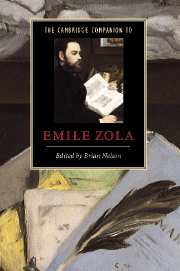Book contents
- Frontmatter
- 1 Zola and the nineteenth century
- 2 Family histories and family plots
- 3 Zola and the representation of society
- 4 Questions of sexuality and gender
- 5 Zola and contemporary painting
- 6 Zola and the art of fiction
- 7 Thérèse Raquin: animal passion and the brutality of reading
- 8 Nana: the world, the flesh and the devil
- 9 Germinal: the gathering storm
- 10 La Bête humaine: Zola and the poetics of the unconscious
- 11 Zola’s utopias
- 12 ‘J’accuse...!’: Zola and the Dreyfus Affair
- Further reading
- Index
10 - La Bête humaine: Zola and the poetics of the unconscious
Published online by Cambridge University Press: 28 May 2007
- Frontmatter
- 1 Zola and the nineteenth century
- 2 Family histories and family plots
- 3 Zola and the representation of society
- 4 Questions of sexuality and gender
- 5 Zola and contemporary painting
- 6 Zola and the art of fiction
- 7 Thérèse Raquin: animal passion and the brutality of reading
- 8 Nana: the world, the flesh and the devil
- 9 Germinal: the gathering storm
- 10 La Bête humaine: Zola and the poetics of the unconscious
- 11 Zola’s utopias
- 12 ‘J’accuse...!’: Zola and the Dreyfus Affair
- Further reading
- Index
Summary
The title of La Bête humaine clearly links it to Darwin's Origin of Species and The Descent of Man; notions about primitive instinct, passion and aggression are the novel's very basis. Yet evolution theory itself converged with psychiatric notions about hysteria and madness, as the theory of degeneration meshed with Darwinist fantasies of regression to primitive states. The pathologies of degeneration included, among other problems, epilepsy, alcoholism, hysteria and idiocy, which were believed to be hereditary or to have an important hereditary component, and were defined by their constitutionally regressive character. Regression signalled reverse evolution, but it also referred to the predominance of the lower, automatic forms of human activity - automatic reflexes, thoughts and acts - that characterised epilepsy, somnambulism and hysteria. Zola exploits this convergence and moves beyond previous depictions of these nervous disorders as they recur throughout the cycle (hysteria is at the root of the Rougon-Macquart family tree, in the person of Tante Dide). Whereas he had previously ascribed the nervous disorders to heredity, here in the 1890 novel his treatment is considerably subtler, moving between physiology, heredity and the new psychological theories of the mind proposed by Pierre Janet.
Zola wrote that he wanted the violent drama of La Bête humaine to possess 'an aura of mystery . . . something that seems to depart from reality (not hypnosis, but an unknown force)' ['un côté ote de mystère . . . quelque chose qui ait l'air de sortir de la realité (pas d'hypnotisme, mais une force inconnue)']. This 'hallucinatory', unknown force will be found in the mechanical, involuntary, automatic aspects of human behaviour that lie beyond the control of reason and the will, behaviour that resembles automatic reflex and locomotor problems such as tics and convulsive movement.
- Type
- Chapter
- Information
- The Cambridge Companion to Zola , pp. 152 - 168Publisher: Cambridge University PressPrint publication year: 2007
- 1
- Cited by



